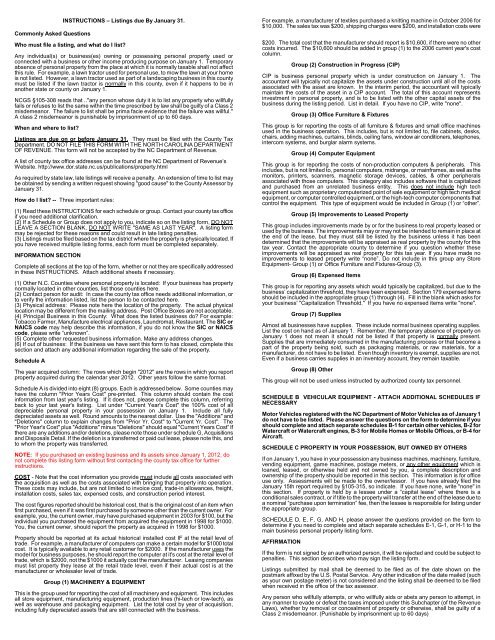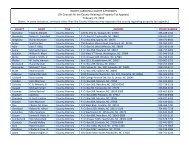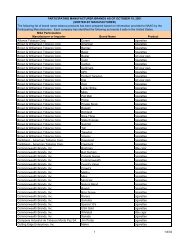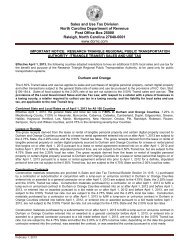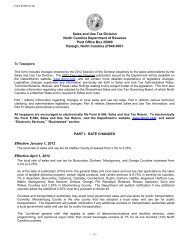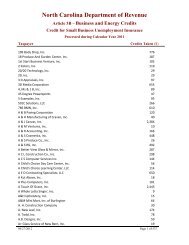Business Personal Property Listing - Department of Revenue
Business Personal Property Listing - Department of Revenue
Business Personal Property Listing - Department of Revenue
Create successful ePaper yourself
Turn your PDF publications into a flip-book with our unique Google optimized e-Paper software.
Commonly Asked Questions<br />
INSTRUCTIONS – <strong>Listing</strong>s due By January 31.<br />
Who must file a listing, and what do I list?<br />
Any individual(s) or business(es) owning or possessing personal property used or<br />
connected with a business or other income producing purpose on January 1. Temporary<br />
absence <strong>of</strong> personal property from the place at which it is normally taxable shall not affect<br />
this rule. For example, a lawn tractor used for personal use, to mow the lawn at your home<br />
is not listed. However, a lawn tractor used as part <strong>of</strong> a landscaping business in this county<br />
must be listed if the lawn tractor is normally in this county, even if it happens to be in<br />
another state or county on January 1.<br />
NCGS §105-308 reads that .."any person whose duty it is to list any property who willfully<br />
fails or refuses to list the same within the time prescribed by law shall be guilty <strong>of</strong> a Class 2<br />
misdemeanor. The failure to list shall be prima facie evidence that the failure was willful."<br />
A class 2 misdemeanor is punishable by imprisonment <strong>of</strong> up to 60 days.<br />
When and where to list?<br />
<strong>Listing</strong>s are due on or before January 31. They must be filed with the County Tax<br />
<strong>Department</strong>. DO NOT FILE THIS FORM WITH THE NORTH CAROLINA DEPARTMENT<br />
OF REVENUE. This form will not be accepted by the NC <strong>Department</strong> <strong>of</strong> <strong>Revenue</strong>.<br />
A list <strong>of</strong> county tax <strong>of</strong>fice addresses can be found at the NC <strong>Department</strong> <strong>of</strong> <strong>Revenue</strong>’s<br />
Website. http://www.dor.state.nc.us/publications/property.html<br />
As required by state law, late listings will receive a penalty. An extension <strong>of</strong> time to list may<br />
be obtained by sending a written request showing "good cause" to the County Assessor by<br />
January 31.<br />
How do I list? -- Three important rules:<br />
(1) Read these INSTRUCTIONS for each schedule or group. Contact your county tax <strong>of</strong>fice<br />
if you need additional clarification.<br />
(2) If a Schedule or Group does not apply to you, indicate so on the listing form, DO NOT<br />
LEAVE A SECTION BLANK, DO NOT WRITE "SAME AS LAST YEAR". A listing form<br />
may be rejected for these reasons and could result in late listing penalties.<br />
(3) <strong>Listing</strong>s must be filed based on the tax district where the property is physically located. If<br />
you have received multiple listing forms, each form must be completed separately.<br />
INFORMATION SECTION<br />
Complete all sections at the top <strong>of</strong> the form, whether or not they are specifically addressed<br />
in these INSTRUCTIONS. Attach additional sheets if necessary.<br />
(1) Other N.C. Counties where personal property is located: If your business has property<br />
normally located in other counties, list those counties here.<br />
(2) Contact person for audit: In case the county tax <strong>of</strong>fice needs additional information, or<br />
to verify the information listed, list the person to be contacted here.<br />
(3) Physical address: Please note here the location <strong>of</strong> the property. The actual physical<br />
location may be different from the mailing address. Post Office Boxes are not acceptable.<br />
(4) Principal <strong>Business</strong> in this County: What does the listed business do? For example:<br />
Tobacco Farmer, Manufacture electrical appliances, Laundromat, Restaurant. The SIC or<br />
NAICS code may help describe this information, if you do not know the SIC or NAICS<br />
code, please write “unknown”.<br />
(5) Complete other requested business information. Make any address changes.<br />
(6) If out <strong>of</strong> business: If the business we have sent this form to has closed, complete this<br />
section and attach any additional information regarding the sale <strong>of</strong> the property.<br />
Schedule A<br />
The year acquired column: The rows which begin "2012" are the rows in which you report<br />
property acquired during the calendar year 2012. Other years follow the same format.<br />
Schedule A is divided into eight (8) groups. Each is addressed below. Some counties may<br />
have the column "Prior Years Cost" pre-printed. This column should contain the cost<br />
information from last year's listing. If it does not, please complete this column, referring<br />
back to your last year's listing. List under "Current Year's Cost" the 100% cost <strong>of</strong> all<br />
depreciable personal property in your possession on January 1. Include all fully<br />
depreciated assets as well. Round amounts to the nearest dollar. Use the "Additions" and<br />
"Deletions" column to explain changes from "Prior Yr. Cost" to "Current Yr. Cost". The<br />
"Prior Year's Cost" plus "Additions" minus "Deletions" should equal "Current Years Cost” If<br />
there are any additions and/or deletions, please note those under schedule G, Acquisitions<br />
and Disposals Detail. If the deletion is a transferred or paid out lease, please note this, and<br />
to whom the property was transferred.<br />
NOTE: If you purchased an existing business and its assets since January 1, 2012, do<br />
not complete this listing form without first contacting the county tax <strong>of</strong>fice for further<br />
instructions.<br />
COST - Note that the cost information you provide must include all costs associated with<br />
the acquisition as well as the costs associated with bringing that property into operation.<br />
These costs may include, but are not limited to invoice cost, trade-in allowances, freight,<br />
installation costs, sales tax, expensed costs, and construction period interest.<br />
The cost figures reported should be historical cost, that is the original cost <strong>of</strong> an item when<br />
first purchased, even if it was first purchased by someone other than the current owner. For<br />
example, you, the current owner, may have purchased equipment in 2003 for $100, but the<br />
individual you purchased the equipment from acquired the equipment in 1998 for $1000.<br />
You, the current owner, should report the property as acquired in 1998 for $1000.<br />
<strong>Property</strong> should be reported at its actual historical installed cost IF at the retail level <strong>of</strong><br />
trade. For example, a manufacturer <strong>of</strong> computers can make a certain model for $1000 total<br />
cost. It is typically available to any retail customer for $2000. If the manufacturer uses the<br />
model for business purposes, he should report the computer at it's cost at the retail level <strong>of</strong><br />
trade, which is $2000, not the $1000 it actually cost the manufacturer. Leasing companies<br />
must list property they lease at the retail trade level, even if their actual cost is at the<br />
manufacturer or wholesaler level <strong>of</strong> trade.<br />
Group (1) MACHINERY & EQUIPMENT<br />
This is the group used for reporting the cost <strong>of</strong> all machinery and equipment. This includes<br />
all store equipment, manufacturing equipment, production lines (hi-tech or low-tech), as<br />
well as warehouse and packaging equipment. List the total cost by year <strong>of</strong> acquisition,<br />
including fully depreciated assets that are still connected with the business.<br />
For example, a manufacturer <strong>of</strong> textiles purchased a knitting machine in October 2006 for<br />
$10,000. The sales tax was $200, shipping charges were $200, and installation costs were<br />
$200. The total cost that the manufacturer should report is $10,600, if there were no other<br />
costs incurred. The $10,600 should be added in group (1) to the 2006 current year's cost<br />
column.<br />
Group (2) Construction in Progress (CIP)<br />
CIP is business personal property which is under construction on January 1. The<br />
accountant will typically not capitalize the assets under construction until all <strong>of</strong> the costs<br />
associated with the asset are known. In the interim period, the accountant will typically<br />
maintain the costs <strong>of</strong> the asset in a CIP account. The total <strong>of</strong> this account represents<br />
investment in personal property, and is to be listed with the other capital assets <strong>of</strong> the<br />
business during the listing period. List in detail. If you have no CIP, write "none".<br />
Group (3) Office Furniture & Fixtures<br />
This group is for reporting the costs <strong>of</strong> all furniture & fixtures and small <strong>of</strong>fice machines<br />
used in the business operation. This includes, but is not limited to, file cabinets, desks,<br />
chairs, adding machines, curtains, blinds, ceiling fans, window air conditioners, telephones,<br />
intercom systems, and burglar alarm systems.<br />
Group (4) Computer Equipment<br />
This group is for reporting the costs <strong>of</strong> non-production computers & peripherals. This<br />
includes, but is not limited to, personal computers, midrange, or mainframes, as well as the<br />
monitors, printers, scanners, magnetic storage devices, cables, & other peripherals<br />
associated with those computers. This category also includes s<strong>of</strong>tware that is capitalized<br />
and purchased from an unrelated business entity. This does not include high tech<br />
equipment such as proprietary computerized point <strong>of</strong> sale equipment or high tech medical<br />
equipment, or computer controlled equipment, or the high-tech computer components that<br />
control the equipment. This type <strong>of</strong> equipment would be included in Group (1) or “other”.<br />
Group (5) Improvements to Leased <strong>Property</strong><br />
This group includes improvements made by or for the business to real property leased or<br />
used by the business. The improvements may or may not be intended to remain in place at<br />
the end <strong>of</strong> the lease, but they must still be listed by the business unless it has been<br />
determined that the improvements will be appraised as real property by the county for this<br />
tax year. Contact the appropriate county to determine if you question whether these<br />
improvements will be appraised as real property for this tax year. If you have made no<br />
improvements to leased property write “none”. Do not include in this group any Store<br />
Equipment- Group (1) or Office Furniture and Fixtures-Group (3).<br />
Group (6) Expensed Items<br />
This group is for reporting any assets which would typically be capitalized, but due to the<br />
business’ capitalization threshold, they have been expensed. Section 179 expensed items<br />
should be included in the appropriate group (1) through (4). Fill in the blank which asks for<br />
your business' "Capitalization Threshold." If you have no expensed items write "none".<br />
Group (7) Supplies<br />
Almost all businesses have supplies. These include normal business operating supplies.<br />
List the cost on hand as <strong>of</strong> January 1. Remember, the temporary absence <strong>of</strong> property on<br />
January 1 does not mean it should not be listed if that property is normally present.<br />
Supplies that are immediately consumed in the manufacturing process or that become a<br />
part <strong>of</strong> the property being sold, such as packaging materials, or raw materials, for a<br />
manufacturer, do not have to be listed. Even though inventory is exempt, supplies are not.<br />
Even if a business carries supplies in an inventory account, they remain taxable.<br />
Group (8) Other<br />
This group will not be used unless instructed by authorized county tax personnel.<br />
SCHEDULE B VEHICULAR EQUIPMENT - ATTACH ADDITIONAL SCHEDULES IF<br />
NECESSARY<br />
Motor Vehicles registered with the NC <strong>Department</strong> <strong>of</strong> Motor Vehicles as <strong>of</strong> January 1<br />
do not have to be listed. Please answer the questions on the form to determine if you<br />
should complete and attach separate schedules B-1 for certain other vehicles, B-2 for<br />
Watercraft or Watercraft engines, B-3 for Mobile Homes or Mobile Offices, or B-4 for<br />
Aircraft.<br />
SCHEDULE C PROPERTY IN YOUR POSSESSION, BUT OWNED BY OTHERS<br />
If on January 1, you have in your possession any business machines, machinery, furniture,<br />
vending equipment, game machines, postage meters, or any other equipment which is<br />
loaned, leased, or otherwise held and not owned by you, a complete description and<br />
ownership <strong>of</strong> the property should be reported in this section. This information is for <strong>of</strong>fice<br />
use only. Assessments will be made to the owner/lessor. If you have already filed the<br />
January 15th report required by §105-315, so indicate. If you have none, write "none" in<br />
this section. If property is held by a lessee under a “capital lease” where there is a<br />
conditional sales contract, or if title to the property will transfer at the end <strong>of</strong> the lease due to<br />
a nominal “purchase upon termination” fee, then the lessee is responsible for listing under<br />
the appropriate group.<br />
SCHEDULE D, E, F, G, AND H, please answer the questions provided on the form to<br />
determine if you need to complete and attach separate schedules E-1, G-1, or H-1 to the<br />
main business personal property listing form.<br />
AFFIRMATION<br />
If the form is not signed by an authorized person, it will be rejected and could be subject to<br />
penalties. This section describes who may sign the listing form.<br />
<strong>Listing</strong>s submitted by mail shall be deemed to be filed as <strong>of</strong> the date shown on the<br />
postmark affixed by the U.S. Postal Service. Any other indication <strong>of</strong> the date mailed (such<br />
as your own postage meter) is not considered and the listing shall be deemed to be filed<br />
when received in the <strong>of</strong>fice <strong>of</strong> the tax assessor.<br />
Any person who willfully attempts, or who willfully aids or abets any person to attempt, in<br />
any manner to evade or defeat the taxes imposed under this Subchapter (<strong>of</strong> the <strong>Revenue</strong><br />
Laws), whether by removal or concealment <strong>of</strong> property or otherwise, shall be guilty <strong>of</strong> a<br />
Class 2 misdemeanor. (Punishable by imprisonment up to 60 days)


